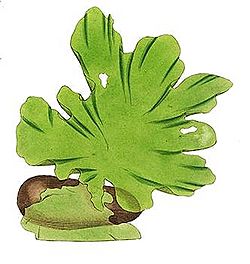Ulvaceae facts for kids
Quick facts for kids Ulvaceae |
|
|---|---|
 |
|
| Ulva lactuca | |
| Scientific classification | |
| Kingdom: | |
| Phylum: | |
| Class: | |
| Order: | |
| Family: |
Ulvaceae
|
| Genera | |
|
|
Ulvaceae is a family of green algae. Think of them as a group of very simple plants that live mostly in water. This family includes the well-known Ulva, which you might have seen washed up on beaches. These algae are an important part of ocean and freshwater ecosystems around the world.
Contents
What Are Ulvaceae?
Ulvaceae are a group of algae that belong to the Chlorophyta phylum, also known as green algae. They get their green color from chlorophyll, just like land plants. Unlike complex plants, Ulvaceae do not have true roots, stems, or leaves. Instead, their body is a simple structure called a thallus. This thallus can look like thin, leafy sheets or long, hair-like strands.
These algae are often found in coastal areas. They can grow on rocks, other algae, or even in sandy bottoms. Some types of Ulvaceae can live in both salty ocean water and fresh water. They are very adaptable and can grow quickly when conditions are right.
Where Do Ulvaceae Live?
Ulvaceae are found all over the world, from cold polar regions to warm tropical seas. Most species live in marine (ocean) environments, especially in shallow coastal waters. They like areas where there is plenty of sunlight, as they need light for photosynthesis. You can often spot them in tide pools, on rocky shores, or floating near the surface.
Some species of Ulvaceae can also live in brackish water, which is a mix of fresh and salt water, like in estuaries. A few types can even be found in pure freshwater lakes and rivers. Their ability to live in different water conditions helps them spread widely across the globe.
How Do Ulvaceae Grow and Reproduce?
Ulvaceae grow by absorbing nutrients directly from the water around them. They use sunlight to make their own food through photosynthesis. Their simple structure allows them to grow quickly, especially in nutrient-rich waters.
The way Ulvaceae reproduce is quite interesting. They can reproduce both sexually and asexually.
- Asexual reproduction: This often happens when a piece of the thallus breaks off and grows into a new plant. This is a fast way for them to spread.
- Sexual reproduction: This involves special cells called gametes. These gametes are released into the water and fuse together to form a zygote. The zygote then develops into a new alga. Many Ulvaceae species show something called "alternation of generations." This means they have two different forms in their life cycle: one that produces spores (sporophyte) and one that produces gametes (gametophyte). Both forms often look very similar.
Why Are Ulvaceae Important?
Ulvaceae play a big role in their ecosystems. They are a primary producer, meaning they create food using sunlight. This makes them a food source for many marine animals, including small fish, snails, and sea urchins. They also provide shelter for tiny creatures.
Sometimes, if there are too many nutrients in the water (often from pollution), Ulvaceae can grow very fast. This rapid growth is called an "algal bloom." While some blooms are natural, large blooms can sometimes cause problems. They can block sunlight from reaching other organisms and, when they die, their decay can use up oxygen in the water, harming other marine life.
Sea Lettuce: A Common Example
The most famous member of the Ulvaceae family is Ulva lactuca, commonly known as sea lettuce. It gets its name because its thin, wavy thallus looks a lot like a leaf of lettuce. Sea lettuce is bright green and can grow up to 18 inches (45 cm) long.
Sea lettuce is edible and has been used as food in many cultures, especially in Asia. It is rich in vitamins and minerals. It can be eaten raw in salads, cooked in soups, or dried and used as a seasoning. Its mild, slightly salty taste makes it a unique ingredient.
See also
 In Spanish: Ulvaceae para niños
In Spanish: Ulvaceae para niños

